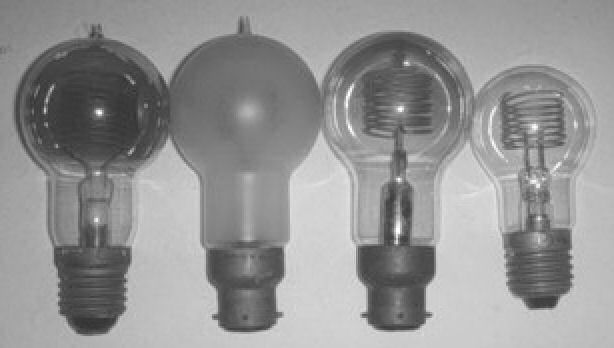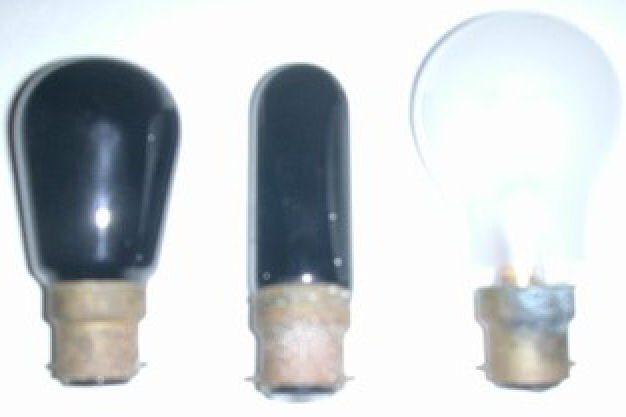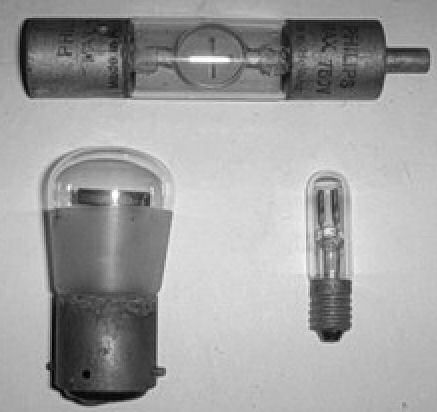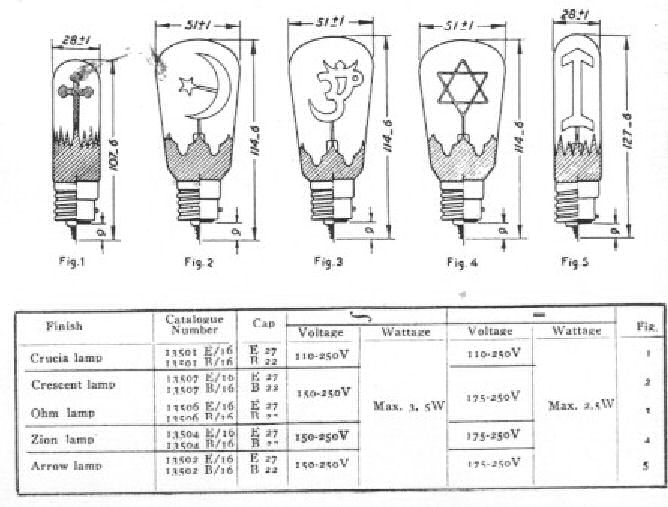Philips Night Light Bulbs
The Philips company in Holland listed a neon night light bulb in their July 1921 catalog, in two voltage sizes - 110 and 150. 220 volt bulbs were available on request. The bulb shown in the catalog is outside frosted and fitted with an Edison screw base. The elements were double helixes of stout wire. Fig.1 shows four of this style of bulb, the left clear, 110 volts and actually day-dated 25/5/21. (Philips used the day/month/year dating system on some bulbs for at least 10 years from 1910). The next bulb - frosted - is 240 volts, the tipless bulb at left 240 volts and dating about 1930. The smaller bulb is 120 volts and dates about 1935.

Fig.1
In the November 1923 catalog, Philips offered the clear and frosted bulbs with tips but had added a white glass tipless bulb to the range. I have never seen one of these but understand one is in a bulb collection in Tasmania. These bulbs were very popular and similar to the British "beehive" types. The original bulb size was what could be said to be a PS19. The 1955 catalog lists them with an A17 bulb size and they were available with inside frosting or internal white fluorescent coating, which gave a greenish light. It appears that these were discontinued about 1960.
Philips Religious, or Emblem Neon Bulbs
The september 1927 Philips General Catalog lists two additional neon bulbs to their range - a "cross" bulb (or "Crucia") and a "Zion" bulb. The latter bulb having two Star of Davids' as elements. They were available with either Edison screw or bayonet bases. They had an S17 bulb and the lower half was obscured with a fancy outside frosted skirt to hide the resistor, which was in the stem. In the March 1930 catalog, the bulb shape of the Crucia was shown as tubular - T9 - and this shape didn't change until these bulbs were discontinued in the early 1960's. The Zion bulb retained the same S17 size. in 1934, the "arrow" bulb was introduced with double arrow elements pointing upwards from the base and a bulb length 20 mm longer than the Crucia. The 1955 catalog shows illustrations of five Philips religious bulbs and a copy of this is shown. The two additional bulbs are the "Crescent" and "Ohm" types. The Edison screw base bulbs on all of the religious bulbs right from the start all had a spring soldered to the centre contact, so that the bulb could be screwed into the socket to a desired position, the spring allowing for the electrical contact. Neon bulbs have from other manufacturers have also been found with this method. Fig.2 shows the four Religious bulbs in my collection and the bulb on the right is something else. It has one element as a zig-zag wire, open at the top, and the other an oval plate about 3/4 inch wide by 2 inches high. Etched onto this is a drawing of the Madonna and Child. This gas in this bulb is argon and it does not appear in any Philips catalogs I have seen. It was found here in Australia by me many years ago.

Fig.2
Philips Argon Gas Ultraviolet Bulbs
The 1955 Philips catalog lists two argon filled bulbs with double helix elements. One is shown clear and one with Woods "black" glass. They were fitted either with Edison screw or bayonet bases, S14 bulb size and came in either AC or DC. They were used for fluorescent activation. One is shown in Fig.3 at left and a tubular version of the same bulb is at right. I don't know if the tubular bulb was made with clear glass. The bulb at right is an A17 size, inside frosted argon, with the elements as two small sheets of mesh about half an inch square. I don't have any information on this bulb other than it has a resistor in the base and works on 240 volts.

Philips Neon Indicator Bulbs
Philips made a range of indicator bulbs and some of these are listed in the 1930 catalog. At the time they offered three types, two being shown in Fig.4. These are - top - a tension indicator bulb made to operate on voltages ranging from 110 to 750. One element was a ring, circling the other which was a round plate with a cross in it. The bulb at bottom left is a "pilot" bulb and these were very common. They were made to operate on 110 or 220/240 volts and had the appropriate resistor in the base. The lower part of the bulb was outside frosted. They also had a ring element circling a plate. Similar bulbs were made in T5 bulb sizes and fitted with small bayonet bases for use in the many Philips radio and related items on the market in the late 1920's and onwards. These were also fitted with "Small" (E14) and American candelabra (E12) screw bases. This size bulb had a cream paint sprayed around the lower half of the bulb. The 1955 Philips catalog lists seven indicator bulbs which could be supplied either with, or without, resistors. The catalog also lists a "wavelength" bulb and one of these is at bottom right in Fig.4 This has a "C6" base.

Fig.4
I have used American bulb size designations in eighths of an inch. Also, I am not aware of Philips making number or letter bulbs. If any do exist, please let me know.

Scan of original Philips catalog depicting various neon emblem lamps.











